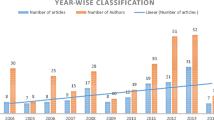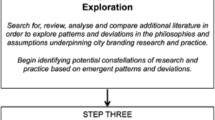Abstract
After years of separate development, there has recently been a convergence between the academic domains of urban policy, tourism and mainstream branding resulting in the emergence of a new domain of place branding. This convergence has, in part, been assisted by developments in the mainstream branding domain associated with corporate and services brands. At the same time, at least one book and several articles have been published, setting out agendas for future research. However, these might be regarded as deficient in two ways. First, they take no account of the conceptual development of mainstream branding theory, and second they take no account of the views of practitioners. In both these cases, further opportunities for research might be identified. This article addresses these deficiencies by supplementing the recently published research agendas with a thematic review of the mainstream branding and place branding literatures, and field interviews with 25 senior managers in place branding organisations. The identified themes are compared with recently published place branding research agendas and a cross-disciplinary agenda for future research is discussed.

Similar content being viewed by others
References
Aaker, D. (1991) Managing Brand Equity: Capitalizing on the Value of a Brand. New York: The Free Press.
Aaker, D. (1996) Building Strong Brands. New York: The Free Press.
Aaker, D. and Joachimstaler, E. (2000) Brand Leadership. New York: The Free Press.
Aaker, D. and Keller, K.L. (1990) Consumer evaluations of brand extensions. Journal of Marketing 54 (January): 27–41.
American Marketing Association. (1960) Marketing Definitions: A Glossary of Marketing Terms. Chicago, IL: American Marketing Association.
Ashworth, G. and Voogd, H. (1990) Can places be sold for tourism? In: G. Ashworth and B. Goodall (eds.) Marketing Tourism Places. London: Routledge.
Balakrishnan, M. (2009) Strategic branding of destinations: A framework. European Journal of Marketing 43 (5/6): 611–629.
Balmer, J. and Soenen, G. (1999) The acid test™ of corporate identity management. Journal of Marketing Management 15 (1–3): 69–92.
Borchert, J. (1994) Urban marketing: A review. In: G. Braun (ed.) Managing and Marketing of Urban Development and Urban Life. Berlin, Germany: Dietrich, Reimer, Verlag.
Boulding, K. (1956) The Image. Ann Arbor, MI: University of Michigan Press.
Burgess, J. (1982) Selling places: Environmental images for the executive. Regional Studies 32 (1): 1–17.
Burmann, C. and Zeplin, S. (2005) Building brand commitment: A behavioural approach to internal brand management. Journal of Brand Management 12 (4): 279–300.
de Chernatony, L. and Dall'Olmo Riley, F. (1998) Defining a brand: Beyond the literature with the views of experts. Journal of Marketing Management 14 (5): 417–444.
de Chernatony, L. and Segal-Horn, S. (2001) Building on services’ characteristics to develop successful services brands. Journal of Marketing Management 17 (7–8): 645–670.
Dinnie, K. (2004) Place Branding: Overview of an Emerging Literature, Place Branding 1 (1): 106–110.
Dinnie, K. (2008) Nation Branding Concepts, Issues, and Practice. London: Butterworth-Heinemann.
Doyle, P. (1989) Building successful brands: The strategic options. Journal of Marketing Management 5 (1): 77–95.
Ewing, M. and Napoli, J. (2004) Developing and validating a multidimensional nonprofit brand orientation scale. Journal of Business Research 58 (6): 841–853.
Flagestad, A. and Hope, C. (2001) Scandinavian winter: Antecedents, concepts and empirical observations underlying destination umbrella branding models. Tourism Review 56 (1–2): 5–12.
Gardner, B. and Levy, S. (1955) The product and the brand. Harvard Business Review (March/April): 33–39.
Gold, J. and Ward, S. (eds.) (1994) Place Promotion: The Use of Publicity and Marketing to Sell Places. Chichester, UK: John Wiley and Sons.
Grangsjo, Y. (2003) Destination networking: Co-opetition in peripheral surroundings. International Journal of Distribution and Logistics Management 33 (5): 427–448.
Hankinson, G. (2001) Location branding: A study of twelve English cities. Journal of Brand Management 9 (2): 127–142.
Hankinson, G. (2004) Relational network brands: Towards a conceptual model of place brands. Journal of Vacation Marketing 10 (2): 109–121.
Hankinson, G. (2007) The management of destination brands: Five guiding principles based on recent developments in corporate branding. Journal of Brand Management 14 (3): 240–254.
Hankinson, G. (2009) Managing destination brands: Establishing a theoretical foundation. Journal of Marketing Management 25 (1–2): 97–115.
Hankinson, G. and Cowking, P. (1993) Branding in Action. Maidenhead, UK: McGraw-Hill.
Hankinson, P. (2000) Brand orientation in charity organisations: Qualitative research into key charity sectors. International Journal of Non-profit and Voluntary Sector Marketing 5 (4): 207–219.
Hankinson, P. (2001) Brand orientation in the charity sector: A framework for discussion. International Journal of Non-profit and Voluntary Sector Marketing 6 (3): 231–242.
Hankinson, P. (2004) The internal brand in leading UK charities. Journal of Product and Brand Management 13 (2): 84–93.
Hanna, S. and Rowley, J (2007) An analysis of terminology use in place branding. Journal of Place Branding and Public Diplomacy 4 (1): 622–675.
Hatch, M.J. and Schulz, M. (2003) Bringing the corporation into corporate branding. European Journal of Marketing 37 (7/8): 1041–1064.
Hunt, J.D. (1975) Image as a factor in tourism development. Journal of Travel Research 13 (January): 1–7.
Ind, N. (1997) The Corporate Brand. London: MacMillan.
Ind, N. (2001) Living the Brand. London: Kogan Page.
Iversen, N. and Hem, L. (2008) Provenance associations as core values of place umbrella brands: A framework of characteristics. Journal of European Marketing 42 (5–6): 603–626.
Jankowicz, A. (2000) Business Research Projects, 3rd edn. London: Thompson Learning.
Kapferer, J.-N. (1997) Strategic Brand Management. London: Kogan Page.
Kavaratzis, M. (2004) From city marketing to city branding: Towards a theoretical framework for developing city brands. Journal of Place Branding 1 (1): 58–73.
Kavaratzis, M. (2005) Place branding: A review of trends and conceptual models. The Marketing Review 5 (4): 329–342.
Kavaratzis, M. and Ashworth, G. (2008) Place marketing: How did we get here and where are we going? Journal of Place Management and Development 1 (2): 150–165.
Kearns, G. and Philo, C. (eds.) (1993) Selling Places: The City as Cultural Capital, Past and Present. Oxford, UK: Pergamon.
Keller, K.L. (1993) Conceptualising, measuring and managing customer-based brand equity. Journal of Marketing 57 (1): 1–22.
Keller, K.L. (2003) Building, Measuring, and Managing Brand Equity, 2nd edn. Upper Saddle River, NJ: Pearson Education.
Keller, K.L. and Aaker, D. (1992) The effect of sequential introduction of brand extensions. Journal of Marketing Research 29 (February): 35–50.
King, S. (1991) Building brands in the 1990s. Journal of Marketing Management 7 (1): 3–13.
Knox, S. and Bickerton, D. (2003) The six conventions of corporate branding. European Journal of Marketing 37 (7/8): 998–1016.
Konecnik, M. (2006a) Croatian-based brand equity for Slovenia as a tourism destination. Economic and Business Review 8 (1): 83–108.
Konecnik, M. (2006b) Slovenia: New challenges in enhancing the value of the tourism destination brand. In: D. Hall, M. Smith and B. Marciszewska (eds.) Tourism in the New Europe: The Challenges and Opportunities of EU. Enlargement, Wallingford, UK: CABI.
Konecnik, M. and Gartner, W. (2007) Customer-based brand equity for a destination. Annals of Tourism Research 34 (2): 400–421.
Kotler, P., Asplund, C., Rein, I. and Haider, D. (1999) MarketingPlaces – Europe. Harlow, UK: Pearson Education.
Kotler, P. and Levy, S. (1969) Broadening the concept of marketing. Journal of Marketing 33 (January): 10–15.
Langeard, E., Bateson, J., Lovelock, C. and Eiglier, P. (1981) Marketing of Services: New Insights from Consumers and Managers. Report No. 81-104. Cambridge, MA: Marketing Sciences Institute.
Louro, M. and Cunha, P. (2001) Brand management paradigms. Journal of Marketing Management 17 (7–8): 849–902.
Low, G. and Fullerton, R. (1994) Brands, brand management and the brand manager system: A critical-historical evaluation. Journal of Marketing Research 31 (May): 173–190.
Merrilees, B., Getz, B. and O'Brien, D. (2005) Marketing stakeholder analysis: Branding the Brisbane Goodwill games. European Journal of Marketing 39 (9–10): 1066–1077.
Miles, M.B. and Huberman, M.A. (1994) Qualitative Data Analysis. Thousand Island Oaks, CA: Sage.
Morgan, N. and Pritchard, A. (1999) Editorial. Journal of Vacation Marketing 5 (3): 213–214.
Morgan, N., Pritchard, A. and Pride, R. (2002) Destination Branding: Creating the Unique Destination Proposition. Oxford, UK: Butterworth-Heinemann.
Napoli, J. (2006) The impact of non-profit brand orientation on organisational performance. Journal of Marketing Management 22 (7): 673–694.
Olutayo, B. and Melewar, T (2008) Corporate brand differentiation in the financial services industry – Applying the highest central common factor concept to nation branding. In: K. Dinnie (ed.) Nation Branding Concepts, Issues, and Practice. London: Butterworth-Heinemann.
Park, C.W., Jaworski, B. and McInnis, D. (1986) Strategic brand concept management. Journal of Marketing 50 (October): 135–145.
Pechlaner, H., Raich, F. and Zehrer, A. (2007) The Alps: Challenges and potentials of a brand management. Tourism Analysis 12 (5–6): 359–370.
Pike, S. (2007) Consumer-based brand equity for destinations: Practical DMO performance measures. Journal of Travel and Tourism Marketing 22 (1): 51–61.
Pike, S. (2009) Destination brand positions of a competitive set of near-home destinations. Tourism Management 30: 857–866.
Pocock, D. and Hudson, R (1978) Images of the Urban Environment. London: Macmillan.
Rainisto, S. (2003) Success factors of place marketing: A study of place marketing practices in Northern Europe and the United States. PhD thesis, Helsinki University of Technology, Institute of Strategy and International Business.
Ries, A. and Trout, J. (1972) The positioning era. Advertising Age 24 (April): 35–38.
Ries, A. and Trout, J. (1981) Positioning: The Battle for your Mind, 1st edn. Maidenhead, UK: McGraw-Hill.
Ritchie, B and Ritchie, R. (1998) The Branding of Tourism Destinations: Past Achievements and Future Challenges. Report presented to the 1998 Annual Congress of the International Association of Scientific Experts in Tourism, Marrakech, Morocco, pp. 1–31.
Rust, R., Zeithaml, V. and Lemon, K. (2000) Driving Customer Equity. New York: Free Press.
Schein, E. (1992) Organisational Culture and Leadership, 2nd edn. San Francisco, CA: Jossey-Bass.
Sheth, J., Newmann, B. and Gross, B. (1991) Why we buy what we buy: A theory of consumption values. Journal of Business Research 22: 159–170.
Sirgy, J. (1982) Self-concept in consumer behaviour: A critical review. Journal of Consumer Research 9: 287–300.
Sirgy, J. and Su, C. (2000) Destination image, self-congruity, and travel behaviour: Towards an integrative model. Journal of Travel Research 38 (May): 340–352.
Skinner, H. (2008) The emergence and development of place marketing's confused identity. Journal of Marketing Management 24 (9–10): 915–928.
Swaminathan, V., Fox, R. and Reddy, S. (2001) The impact of brand extension introduction on choice. Journal of Marketing 65 (4): 1–15.
Tauber, E. (1981) Brand franchise extensions: New products benefit from existing brand names. Business Horizons 24 (2): 36–41.
Tilley, C. (1999) Built-in branding: How to engineer a leadership brand. Journal of Marketing Management 15 (1–3): 181–191.
Trueman, M., Klemm, M., Giroud, A. and Lindley, T. (2001) Bradford in the Premier League: A Multi-Disciplinary Approach to Positioning a City. Bradford University School of Management, Working Paper Series, No. 01/04.
Trueman, M., Klemm, M. and Giroud, A. (2004) Can a city communicate? Bradford as a corporate brand. Corporate Communications: An International Journal 9 (4): 317–330.
Urde, M. (1994) Brand orientation – A strategy for survival. Journal of Consumer Marketing 11 (3): 18–31.
Urde, M. (1999) Brand orientation: A mindset for building brands into strategic resources. Journal of Marketing Management 15 (1–3): 117–133.
van den Berg, L., Klaasen, L. and van der Meer, J. (1990) Marketing Metropolitan Regions. Rotterdam, the Netherlands: European Institute of Comparative Urban Research.
Warnaby, G. and Davies, B. (1997) Commentary: Cities as service factories? Using the Servuction system for marketing cities as shopping destinations. International Journal of Retail & Distribution Management 25 (6): 204–210.
Ward, S. (1998) Selling Places: The Marketing of Towns and Cities, 1850–2000. London: Routledge.
Author information
Authors and Affiliations
Corresponding author
Additional information
1has held professorial posts at Thames Valley University and the University of Lincoln. His research career has been devoted to the study of brands and their management. For the past 10 years, his research has focused on the branding of places. He now lectures and researches at London Metropolitan University Business School.
Rights and permissions
About this article
Cite this article
Hankinson, G. Place branding research: A cross-disciplinary agenda and the views of practitioners. Place Brand Public Dipl 6, 300–315 (2010). https://doi.org/10.1057/pb.2010.29
Received:
Revised:
Published:
Issue Date:
DOI: https://doi.org/10.1057/pb.2010.29




